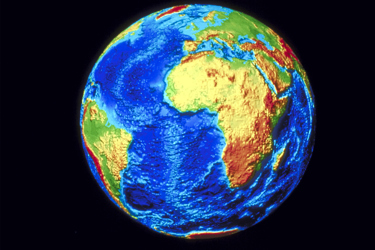From Wildfires To Gas Leaks: How Hyperspectral Imaging Is Detecting Disasters On Earth

By John Oncea, Editor

Hyperspectral satellites analyze Earth's chemical fingerprints from space, enabling crop protection, mineral discovery, and environmental monitoring to combat pollution and climate change impacts.
A couple of summers back we wrote about how infrared is used to help track wildfires. Well, hyperspectral imaging says, “Hold my beer.”
Not only is hyperspectral imaging (HSI) being used to detect wildfire smoke from space, it’s also detecting pipeline leaks and other environmental issues, providing precise monitoring and exploration capabilities for businesses and governments, and more.
HSI detects disasters on Earth by identifying the unique chemical signatures of objects based on how they reflect, absorb, or emit light at different wavelengths. HSI uses more bands of light than other spectral imaging technologies and divides light into narrow spectral bands across the electromagnetic spectrum, typically between visible and infrared wavelengths.
HSI can be used to identify specific chemicals and materials in an image, which can help with a variety of applications. For example, HSI can be used to:
- Detect leaks in pipelines
- Identify areas susceptible to wildfire
- Detect valuable materials for mining
- Assess the health of crops
- Forecast and monitor landslides
- Quantify weather events
- Detect mostly invisible chemical hazards
HSI can be used with space-based, airborne, or unmanned aerial systems, as well as with lab-based imaging systems.
Disaster Detection And Analysis
HSI can detect and analyze various types of disasters by capturing detailed spectral information across hundreds of narrow wavelength bands, writes The World Economic Forum. This allows it to identify unique “spectral fingerprints” of materials and phenomena associated with disasters.
Take, for example, volcanic eruptions. HSI can detect precursor signals like increased thermal activity and gas emissions before an eruption, writes NASA. In addition, it can track lava flows and ash plumes during eruptions, as well as monitor post-eruption landscape changes and hazards. The ability to detect subtle thermal and chemical changes enables early warning of volcanic activity.
HSI also can help monitor landslides by analyzing soil moisture content and composition to assess landslide risk, detecting early signs of ground movement and instability, and mapping affected areas after landslide events. When combined with topographic data, it can produce detailed landslide susceptibility maps.
For flood events, hyperspectral sensors can assess soil saturation levels to determine flooding potential, map inundated areas and water depth, and monitor water quality and contamination in flood waters.
Oil spills? HSI excels at detecting and mapping oil spills by identifying the unique spectral signature of oil on water surfaces, estimating oil thickness and type, and monitoring the spread and environmental impact of spills.
HSI offers several key benefits for disaster detection and response, including early warning as the ability to detect subtle changes enables earlier identification of potential hazards. It also enables detailed analysis because hundreds of spectral bands provide rich data for in-depth assessment of disaster impacts and risks.
Satellite-based hyperspectral sensors can rapidly survey large areas with a single hyperspectral image providing comprehensive information about a disaster scene, reducing the need for multiple data sources.
HIS, SAR, LiDAR, And More
While HSI is a powerful tool, it’s important to note it’s often used in conjunction with other remote sensing technologies for comprehensive disaster monitoring and management including multispectral Imaging.
While hyperspectral sensors capture hundreds of narrow spectral bands, multispectral sensors capture fewer, broader bands. The combination allows hyperspectral data to provide detailed spectral analysis and multispectral data to offer wider coverage and higher temporal resolution. This integration enables both broad monitoring and targeted analysis of disaster-affected areas.
Synthetic Aperture Radar (SAR) provides high-resolution imagery regardless of weather conditions or time of day. When combined with hyperspectral data, it allows:
- All-weather monitoring capabilities
- Detection of surface changes and deformations
- Enhanced identification of materials and objects
This integration is particularly useful for monitoring disasters like floods or landslides in cloudy conditions.
LiDAR provides detailed 3D topographic information. Integrating LiDAR with hyperspectral data enables:
- Precise mapping of disaster impacts on terrain
- Improved analysis of vegetation structure and health
- Better understanding of flood dynamics or landslide risks
Integration With Ground-Based Data
HSI data is often combined with ground-based information for comprehensive disaster management. This includes ground-based sensors that provide real-time, localized data. Integration with HSI allows for the calibration and validation of satellite-based observations, as well as more accurate interpretation of spectral signatures. It also enables early warning systems for disasters like floods or volcanic eruptions.
On-the-ground assessments by disaster response teams can be combined with hyperspectral data to verify and refine remote sensing observations, assess damage to infrastructure and ecosystems, and guide resource allocation for disaster response.
Finally, advanced data fusion techniques are used to integrate HSI with other data sources:
- Machine learning algorithms can combine multiple data types to improve disaster detection and classification
- Geographic Information Systems (GIS) integrate spatial data from various sources for comprehensive analysis
- Time-series analysis of combined datasets can reveal trends and patterns in disaster evolution
Applications In Disaster Management
This integrated approach enhances various aspects of disaster management starting with early warning. Combining hyperspectral data with other sources improves the detection of precursor signals for events like landslides or volcanic eruptions.
Damage assessment is also enhanced as the integration of HSI with SAR and ground surveys provides a more complete picture of disaster impacts. Response planning is improved because fused datasets help optimize resource allocation and guide rescue operations. Finally, long-term integration of hyperspectral and other data sources enables tracking of ecosystem recovery and reconstruction efforts resulting in improved recovery monitoring.
By leveraging the strengths of multiple remote sensing technologies and ground-based data, hyperspectral imaging contributes to a more comprehensive and effective approach to disaster monitoring and management.
